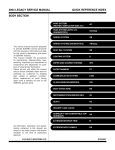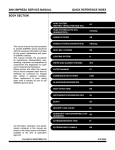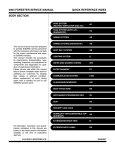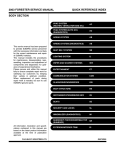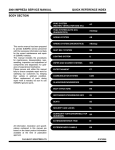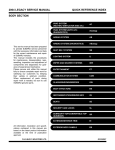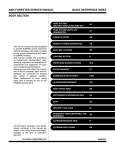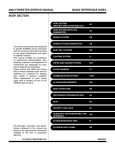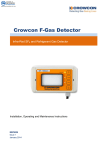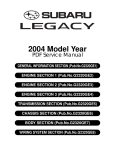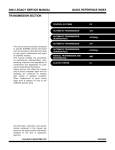Download 2004 IMPREZA SERVICE MANUAL QUICK
Transcript
2004 IMPREZA SERVICE MANUAL QUICK REFERENCE INDEX BODY SECTION This service manual has been prepared to provide SUBARU service personnel with the necessary information and data for the correct maintenance and repair of SUBARU vehicles. This manual includes the procedures for maintenance, disassembling, reassembling, inspection and adjustment of components and diagnostics for guidance of experienced mechanics. Please peruse and utilize this manual fully to ensure complete repair work for satisfying our customers by keeping their vehicle in optimum condition. When replacement of parts during repair work is needed, be sure to use SUBARU genuine parts. All information, illustration and specifications contained in this manual are based on the latest product information available at the time of publication approval. FUJI HEAVY INDUSTRIES LTD. HVAC SYSTEM (HEATER, VENTILATOR AND A/C) AC HVAC SYSTEM (AUTO A/C) (DIAGNOSTICS) AC(diag) AIRBAG SYSTEM AB AIRBAG SYSTEM (DIAGNOSTICS) AB(diag) SEAT BELT SYSTEM SB LIGHTING SYSTEM LI WIPER AND WASHER SYSTEMS WW ENTERTAINMENT ET COMMUNICATION SYSTEM COM GLASS/WINDOWS/MIRRORS GW BODY STRUCTURE BS INSTRUMENTATION/DRIVER INFO IDI SEATS SE SECURITY AND LOCKS SL SUNROOF/T-TOP/CONVERTIBLE TOP (SUNROOF) SR EXTERIOR/INTERIOR TRIM EI EXTERIOR BODY PANELS EB G1870GE6 2004 IMPREZA SERVICE MANUAL QUICK REFERENCE INDEX BODY SECTION CRUISE CONTROL SYSTEM CC CRUISE CONTROL SYSTEM (DIAGNOSTICS) CC(diag) IMMOBILIZER (DIAGNOSTICS) IM(diag) G1870GE6 HVAC SYSTEM (HEATER, VENTILATOR AND A/C) AC 1. 2. 3. 4. 5. 6. 7. 8. 9. 10. 11. 12. 13. 14. 15. 16. 17. 18. 19. 20. 21. 22. 23. 24. Page General Description ....................................................................................2 Refrigerant Pressure with Manifold Gauge Set.........................................20 Refrigerant Recovery Procedure...............................................................21 Refrigerant Charging Procedure ...............................................................22 Refrigerant Leak Check ............................................................................25 Compressor Oil .........................................................................................26 Blower Motor Unit Assembly .....................................................................27 Power Transistor (Auto A/C Model) ..........................................................28 Blower Resistor (Without A/C Model and Manual A/C Model) ..................29 Heater Core...............................................................................................30 Control Unit ...............................................................................................31 Compressor...............................................................................................32 Condenser.................................................................................................33 Heater and Cooling Unit............................................................................34 Evaporator.................................................................................................35 Hose and Tube..........................................................................................36 Relay and Fuse .........................................................................................37 Pressure Switch (Dual Switch)..................................................................38 Ambient Sensor (Auto A/C Model) ............................................................39 Sunload Sensor (Auto A/C Model) ............................................................40 Air Vent Grille ............................................................................................41 Heater Duct ...............................................................................................42 Heater Vent Duct.......................................................................................43 General Diagnostic Table..........................................................................44 General Description HVAC SYSTEM (HEATER, VENTILATOR AND A/C) 1. General Description A: SPECIFICATIONS 1. HEATER SYSTEM Item Specifications Condition • Mode selector switch: HEAT • Temperature control switch: FULL HOT • Temperature difference between hot water and inlet air: 65°C (149°F) • Hot water flow rate: 360 2 (95.1 US gal, 79.2 Imp gal)/h Heating capacity 5.0 kW (4,300 kcal/h, 17,062 BTU/h) or more Air flow rate 280 m3 (9,888 cu ft)/h Heat mode (FRESH), FULL HOT at 12.5 V Max air flow rate 450 m3 (15,892 cu ft)/h • Temperature control switch: FULL COLD • Blower fan speed: 4th position • Mode selector lever: RECIRC Heater core size (height × length × width) Type Blower Fan type and size motor (diameter × width) 163.9 × 200 × 25.0 mm (6.45 × 7.87 × 0.984 in) Magnet motor 200 W or less Sirocco fan type 150 × 75 mm (5.91 × 2.95 in) — at 12 V — 2. A/C SYSTEM • AUTO A/C MODEL Item Specifications Reheat air-mix type 5.1 kW (4,385 kcal/h, 17,402 BTU/h) HFC-134a (CH2FCF3) [0.5±0.05 kg (0.99±0.11 lb)] Vane rotary, fix volume (CR-14) Type of air conditioner Cooling capacity Refrigerant Type Compressor Discharge Magnet clutch Max. permissible speed Type Power consumption Type of belt Pulley dia. (effective dia.) Pulley ratio Type Condenser Core thickness 0.21 m2 (2.26 sq ft) 16 mm (0.63 in) Radiation area 5.34 m2 (57.48 sq ft) Core face area Receiver drier Effective inner capacity Expansion valve Type Type Evaporator Dimensions (W × H × T) Blower fan 144 cm3 (8.79 cu in)/rev 7,000 rpm Dry, single-disc type 47 W V-Ribbed 4 PK 125 mm (4.92 in) 1.064 Corrugated fin (Sub cool type) Fan type Outer diameter × width Power consumption AC-2 250 cm3 (15.26 cu in) Internal equalizing Single tank 255 × 200 × 48 mm (10 × 7.87 × 1.89 in) Sirocco fan 150 × 75 mm (5.91 × 2.95 in) 200 W General Description HVAC SYSTEM (HEATER, VENTILATOR AND A/C) Motor type Power consumption Fan outer diameter Motor type Power consumption Fan outer diameter MPFI model Condenser fan (Sub fan) Radiator fan (Main fan) Idling speed (A/C ON) ON → OFF Low-pressure switch operating pressure Dual switch (Pressure switch) High-pressure switch operating pressure Magnet 120 W (Turbo model), 70 W (Non-turbo model) 320 mm (12.6 in) Magnet 120 W (Turbo model), 70 W (Non-turbo model) 320 mm (12.6 in) 850±100 rpm 278±29 kPa (2.83±0.3 kg/cm2, 40.3±4.2 psi) 287+39/−25 kPa OFF → ON (2.9+0.4/−0.25 kg/cm2, 42+5.7/−3.6 psi) 2,800±100 kPa (29±1 kg/cm2, 406±15 psi) 600±200 kPa (6.12±2 kg/cm2, 87±29 psi) ON → OFF DIFF (3) (1) Thermo control amplifier working temperature (Evaporator outlet air) (2) (4) AC-00601 (1) ON (2) OFF (3) 2.5±0.5°C (36.5±0.9°F) (4) 1.5±0.5°C (35±0.9°F) • MANUAL A/C MODEL Item Specifications Reheat air-mix type 5.1 kW (4,385 kcal/h, 17,402 BTU/h) HFC-134a (CH2FCF3) [0.5±0.05 kg (1.10±0.11 lb)] Vane rotary, fix volume (CR-14) Type of air conditioner Cooling capacity Refrigerant Type Compressor Discharge Magnet clutch Max. permissible speed Type Power consumption Type of belt Pulley dia. (effective dia.) Pulley ratio Type 144 cm3 (8.79 cu in)/rev 7,000 rpm Dry, single-disc type 47 W V-Ribbed 4 PK 125 mm (4.92 in) 1.064 Corrugated fin (Sub cool type) Core thickness 0.21 m2 (2.26 sq ft) 16 mm (0.63 in) Radiation area 5.34 m2 (57.48 sq ft) Receiver drier Effective inner capacity Expansion valve Type 250 cm3 (15.26 cu in) Externally equalizing Condenser Core face area AC-3 General Description HVAC SYSTEM (HEATER, VENTILATOR AND A/C) Type Evaporator Dimensions (W × H × T) Blower fan Condenser fan (Sub fan) Radiator fan (Main fan) Idling speed (A/C ON) Fan type Outer diameter × width Power consumption Motor type Power consumption Fan outer diameter Motor type Power consumption Fan outer diameter MPFI model ON → OFF Low-pressure switch operating pressure Dual switch (Pressure switch) High-pressure switch operating pressure Single tank 255 × 200 × 48 mm (10 × 7.87 × 1.89 in) Sirocco fan 150 × 75 mm (5.91 × 2.95 in) 200 W Magnet 120 W (Turbo model), 70 W (Non-turbo model) 320 mm (12.6 in) Magnet 120 W (Turbo model), 70 W (Non-turbo model) 320 mm (12.6 in) 850±100 rpm 278±29 kPa (2.83±0.3 kg/cm2, 40.3±4.2 psi) 287+39/−25 kPa OFF → ON (2.9+0.4/−0.25 kg/cm2, 42+5.7/−3.6 psi) 2,800±100 kPa (29±1 kg/cm2, 406±15 psi) 600±200 kPa (6.12±2 kg/cm2, 87±29 psi) ON → OFF DIFF (3) (1) Thermo control amplifier working temperature (Evaporator outlet air) (2) (4) AC-00601 (1) ON (2) OFF (3) 1.5±0.5°C (35±0.9°F) (4) 3.0±0.5°C (37±0.9°F) AC-4 General Description HVAC SYSTEM (HEATER, VENTILATOR AND A/C) B: COMPONENT 1. HEATER COOLING UNIT • AUTO A/C MODEL (24) (20) (21) (23) T (26) (25) (18) (22) (16) (8) (7) (6) (4) (5) (14) (15) (3) (19) (2) (17) (20) T (20) (1) (10) (13) (11) (12) (9) AC-00603 (1) (2) (3) (4) (5) (6) (7) (8) (9) (10) Unit cover Mode actuator Side link Mode actuator lever Foot lever Spring Mode actuator link Defroster lever Foot nozzle Unit duct cover (11) (12) (13) (14) (15) (16) (17) (18) (19) (20) Heater core clamp Heater core Drain hose Mix actuator Mix actuator lever Unit assembly Aspirator hose Aspirator Foot duct Packing AC-5 (21) (22) (23) (24) (25) (26) Cooling unit block O-ring Expansion valve Evaporator Evaporator cover Thermistor Tightening torque: N·m (kgf-m, ft-lb) T: 7.4 (0.75, 5.4) General Description HVAC SYSTEM (HEATER, VENTILATOR AND A/C) • MANUAL A/C MODEL (20) (16) (17) (19) (22) T (21) (18) (13) (7) (6) (5) (8) (4) (15) (12) (3) (2) (14) T (15) (11) (1) (9) (10) (8) AC-00733 (1) (2) (3) (4) (5) (6) (7) (8) (9) Unit cover Side link Mode lever Foot lever Spring Mode link Defroster lever Foot nozzle Unit duct cover (10) (11) (12) (13) (14) (15) (16) (17) Heater core Drain hose Mix lever Unit assembly Foot duct Clip Packing Cooling unit block AC-6 (18) (19) (20) (21) (22) O-ring Expansion valve Evaporator Evaporator cover Thermistor Tightening torque: N·m (kgf-m, ft-lb) T: 7.4 (0.75, 5.4) General Description HVAC SYSTEM (HEATER, VENTILATOR AND A/C) 2. BLOWER MOTOR UNIT • AUTO A/C MODEL (4) (9) (3) (6) (2) (5) (7) T (10) (1) (11) (12) T (8) AC-00605 (1) (2) (3) (4) (5) Upper case Servo motor Blower link Blower link lever A Blower link lever B (6) (7) (8) (9) (10) Blower link lever C Filter cover Filter Blower motor assembly Hose AC-7 (11) (12) Power transistor Power transistor cover Tightening torque: N·m (kgf-m, ft-lb) T: 7.4 (0.75, 5.4) General Description HVAC SYSTEM (HEATER, VENTILATOR AND A/C) • WITHOUT A/C MODEL AND MANUAL A/C MODEL (8) (2) (4) (3) (5) (6) T (9) (1) (10) T (7) AC-00734 (1) (2) (3) (4) (5) Upper case Blower link Blower link lever A Blower link lever B Clip (6) (7) (8) (9) (10) Filter cover Filter Blower motor assembly Hose Blower resistor AC-8 Tightening torque: N·m (kgf-m, ft-lb) T: 7.4 (0.75, 5.4) General Description HVAC SYSTEM (HEATER, VENTILATOR AND A/C) 3. CONTROL UNIT • AUTO A/C MODEL (9) (7) (6) (10) (8) (2) (4) (5) (3) (1) (2) AC-00607 (1) (2) (3) (4) Switch Control lever Control panel In-vehicle sensor (5) (6) (7) (8) Aspirator hose Switch assembly Control base Electronic control unit AC-9 (9) (10) Bulb Control case General Description HVAC SYSTEM (HEATER, VENTILATOR AND A/C) • WITHOUT A/C MODEL AND MANUAL A/C MODEL (14) (10) (11) (13) (9) (7) (15) (12) (8) (4) (1) (6) (1) (5) (3) (1) (2) AC-00608 (1) (2) (3) (4) (5) Dial Fan control plate Temperature control plate Mode control plate FRESH/RECIRC switching knob (6) (7) (8) (9) (10) Heater control panel A/C switch (with A/C model) Rear window defogger switch Heater control base Intake cable AC-10 (11) (12) (13) (14) (15) Mode cable Temperature cable Bulb Fan switch ASSY Harness General Description HVAC SYSTEM (HEATER, VENTILATOR AND A/C) 4. AIR CONDITIONING UNIT • LHD MODEL (5) (8) (10) (7) T2 (6) (2) (6) (6) T1 (6) (6) (4) T1 T1 T2 T1 (6) T1 (1) (9) (3) T2 (7) (6) T1 AC-00609 (1) (2) (3) (4) (5) Condenser Hose (High-pressure) Hose (Low-pressure) Bracket Compressor (6) (7) (8) (9) (10) O-ring Clamp A Clamp B Tube (To condenser) Tube (To evaporator) AC-11 Tightening torque: N·m (kgf-m, ft-lb) T1: 7.4 (0.75, 5.4) T2: 15 (1.5, 10.8) General Description HVAC SYSTEM (HEATER, VENTILATOR AND A/C) • RHD MODEL (5) T2 (6) (2) (6) (6) (6) (6) (3) T2 T2 T2 T2 (1) (4) (6) T1 AC-00979 (1) (2) (3) Condenser Hose (High-pressure) Hose (Low-pressure) (4) (5) (6) Tube Compressor O-ring AC-12 Tightening torque: N·m (kgf-m, ft-lb) T1: 7.4 (0.75, 5.4) T2: 15 (1.5, 10.8) General Description HVAC SYSTEM (HEATER, VENTILATOR AND A/C) 5. COMPRESSOR T5 (4) (5) T5 T3 T5 (9) (2) (3) (1) T2 T1 (6) (7) T1 T4 (8) AC-00611 (1) (2) (3) (4) (5) (6) Idler pulley bracket Idler pulley adjuster Idler pulley Compressor upper bracket Compressor Compressor lower bracket (7) (8) (9) V-belt Compressor belt cover Compressor belt cover bracket AC-13 Tightening torque: N·m (kgf-m, ft-lb) T1: 7.4 (0.75, 5.4) T2: 22.6 (2.3, 16.6) T3: 23.0 (2.35, 17.0) T4: 28.9 (2.95, 21.3) T5: 35 (3.6, 26) General Description HVAC SYSTEM (HEATER, VENTILATOR AND A/C) 6. HEATER DUCT (2) (1) (3) (4) (5) (7) (6) AC-00612 (1) (2) (3) Front defroster nozzle Side defroster duct (LH) Side defroster duct (RH) (4) (5) (6) Side ventilation duct (LH) Side ventilation duct (RH) Rear heater duct (LH) AC-14 (7) Rear heater duct (RH) General Description HVAC SYSTEM (HEATER, VENTILATOR AND A/C) C: CAUTION 1. HFC-134A A/C SYSTEM • Unlike the old conventional CFC-12 system components, the cooling system components for the HFC-134a system such as the refrigerant and compressor oil are incompatible. • Vehicles with the HFC-134a system can be identified by the label (A) attached to the vehicle. Before maintenance, check which A/C system is installed in the vehicle. (A) If the refrigerant gets into your eye, avoid rubbing your eyes with your hands. Wash your eye with plenty of water, and receive medical treatment from an eye doctor. • Do not heat a service can. If a service can is directly heated, or put into boiling water, the inside pressure will become extremely high. This may cause the can to explode. If a service can must be warmed up, use hot water in 40°C (104°F) max. • Do not drop or impact a service can. (Observe the precautions and operation procedure described on the refrigerant can.) • When the engine is running, do not open the high-pressure valve of the manifold gauge. The high-pressure gas will back-flow resulting in an explosion of the can. • Provide good ventilation and do not work in a closed area. • In order to prevent global warning, avoid releasing HFC-134a into the atmosphere. Using a refrigerant recovery system, discharge and reuse it. AC-00006 2. COMPRESSOR OIL (A) • HFC-134a compressor oil has no compatibility with that for R12 system. • Use only the manufacturer-authorized compressor oil for the HFC-134a system; only use DH-PR. • Do not mix multiple compressor oils. If CFC-12 compressor oil is used in a HFC-134a A/ C system, the compressor may become stuck due to poor lubrication, or the refrigerant may leak due to swelling of rubber parts. On the other hand, if HFC-134a compressor oil is used in a CFC-12 A/C system, the durability of the A/C system will be lowered. • HFC-134a compressor oil is very hygroscopic. When replacing or installing/removing A/C parts, immediately isolate the oil from the atmosphere using a plug or tape. In order to avoid moisture, store the oil in a container with its cap tightly closed. (C) (B) (D) (F) (E) 3. REFRIGERANT AC-00007 • The CFC-12 refrigerant cannot be used in the HFC-134a A/C system. The HFC-134a refrigerant, also, cannot be used in the CFC-12 A/C system. • If an incorrect or no refrigerant is used, poor lubrication will result and the compressor itself may be damaged. 4. HANDLING OF REFRIGERANT • The refrigerant boils at approx. −30°C (−22°F). When handling it, be sure to wear safety goggles and protective gloves. Direct contact of the refrigerant with skin may cause frostbite. AC-15 (A) (B) (C) (D) (E) (F) Goggles Gloves Avoid open flame No direct heat on container Do not discharge Loosen General Description HVAC SYSTEM (HEATER, VENTILATOR AND A/C) 5. O-RING CONNECTIONS • Use new O-rings. • In order to keep the O-rings free of lint which will cause a refrigerant gas leak, perform operations without gloves and shop cloths. • Apply the compressor oil to the O-rings to avoid sticking, then install them. • Use a torque wrench to tighten the O-ring fittings: Over-tightening will damage the O-ring and tube end distortion. • If the operation is interrupted before completing a pipe connection, recap the tubes, components, and fittings with a plug or tape to prevent contamination from entering. • Use the oil specified in the service manual to lubricate the O-rings. Apply the oil to the top and sides of the O-rings before installation. Apply the oil to the area including the O-rings and tube beads. AC-00010 (A) • After tightening, use a clean shop cloth to remove excess oil from the connections and any oil which may have run on the vehicle body or other parts. • If any leakage is suspected after tightening, do not retighten the connections, Disconnect the connections, remove the O-rings, and check the Orings, threads, and connections. AC-00008 D: PREPARATION TOOL (A) Seal • Visually check the surfaces and mating surfaces of O-rings, threads, and connecting points. If a failure is found, replace the applicable parts. • Install the O-rings at right angle to the tube beards. (A) (B) (D) (C) CAUTION: When working on vehicles with the HFC-134a system, only use HFC-134a specified tools and parts. Do not mix with CFC-12 tools and parts. If HFC-134a and CFC-12 refrigerant or compressor oil is mixed, poor lubrication will result and the compressor itself may be destroyed. In order to help prevent mixing HFC-134a and CFC-12 parts and liquid, the tool and screw type and the type of service valves used are different. The gas leak detectors for the HFC-134a and CFC-12 systems must also not be interchanged. (C) Tool & screw type Valve type AC-00009 (A) (B) (C) (D) O-ring OK NG Bead AC-16 HFC-134a Millimeter size Quick joint type CFC-12 Inch size Screw-in type General Description HVAC SYSTEM (HEATER, VENTILATOR AND A/C) Description Tools and Equipment Wrench Various WRENCHES will be required to service any A/C system. A 7 to 40 N·m (0.7 to 4.1 kgf-m, 5 to 30 ft-lb) torque wrench with various crowfoot wrenches will be needed. Open end or flare nut wrenches will be needed for back-up on the tube and hose fittings. AC-00213 Applicator bottle A small APPLICATOR BOTTLE is recommended to apply refrigerant oil to the various parts. They can be obtained at a hardware or drug store. AC-00012 Manifold gauge set A MANIFOLD GAUGE SET (with hoses) can be obtained from either a commercial refrigeration supply house or from an auto shop equipment supplier. AC-00013 Refrigerant recovery system A REFRIGERANT RECOVERY SYSTEM is used for the recovery and reuse of A/C system refrigerant after contaminants and moisture have been removed from the refrigerant. AC-00014 AC-17 General Description HVAC SYSTEM (HEATER, VENTILATOR AND A/C) Description Tools and Equipment Syringe A graduated plastic SYRINGE will be needed to add oil back into the system. The syringe can be found at a pharmacy or drug store. AC-00015 Vacuum pump A VACUUM PUMP (in good working condition) is necessary, and may be obtained from either a commercial refrigeration supply house or an automotive equipment supplier. AC-00016 Can tap A CAN TAP for the 397 g (14 oz) can is available from an auto supply store. AC-00017 Thermometer Pocket THERMOMETERS are available from either industrial hardware store or commercial refrigeration supply houses. AC-00018 AC-18 General Description HVAC SYSTEM (HEATER, VENTILATOR AND A/C) Description Tools and Equipment Electronic leak detector An ELECTRONIC LEAK DETECTOR can be obtained from either a specialty tool supply or an A/C equipment supplier. AC-00019 Weight scale A WEIGHT SCALE such as an electronic charging scale or a bathroom scale with digital display will be needed if a 13.6 kg (30 lb) refrigerant container is used. AC-00020 AC-19 Refrigerant Pressure with Manifold Gauge Set HVAC SYSTEM (HEATER, VENTILATOR AND A/C) 2. Refrigerant Pressure with Manifold Gauge Set A: OPERATION 1) Place the vehicle in the shade and windless condition. 2) Connect the manifold gauge set. 3) Open the front windows and close all doors. 4) Open the front hood. 5) Increase the engine to 1,500 rpm. 6) Turn ON the A/C switch. 7) Turn the temperature control switch to MAX COOL. 8) Put in RECIRC position. 9) Turn the blower control switch to HI. 10) Read the gauge. Standard: Low pressure: 127 — 196 kPa (1.3 — 2.0 kg/cm2, 18 — 28 psi) High pressure: 1,471 — 1,667 kPa (15 — 17 kg/cm2, 213 — 242 psi) Ambient temperature: 30 — 35°C (86 — 95°F) B: INSPECTION Symptom High-pressure side is unusually high. High-pressure side is unusually low. Low-pressure side is unusually high. Low-pressure side is unusually low. • • • • • Probable cause Defective condenser fan motor Clogged condenser fin Too much refrigerant Air inside the system Defective receiver dryer • Defective compressor • Not enough refrigerant • Clogged expansion valve • Expansion valve frozen temporarily by moisture • Defective compressor • Defective expansion valve • Too much refrigerant • Not enough refrigerant • Clogged expansion valve • Expansion valve frozen temporarily by moisture • Saturated receiver dryer AC-20 Repair order • Replace the fan motor. • Clean the condenser fin. • Discharge refrigerant. • Replace the receiver dryer. • After revacuating the receiver dryer, charge appropriate amount of refrigerant. • Replace the compressor. • Check for leaks. • Replace the expansion valve. • Fully evacuate the expansion valve. • • • • • • Replace the compressor. Replace the expansion valve. Discharge refrigerant. Check for leaks. Replace the expansion valve. Replace the receiver dryer. Refrigerant Recovery Procedure HVAC SYSTEM (HEATER, VENTILATOR AND A/C) 3. Refrigerant Recovery Procedure 4) Install the low-/high-pressure hoses to the service ports on the low-/high-pressure sides of the vehicle respectively. A: OPERATION CAUTION: • During operation, be sure to wear safety goggles and protective gloves. • Connect the refrigerant recovery system with the manifold gauge set to discharge the refrigerant from the A/C system and reuse it. • When reusing the discharged refrigerant, keep service cans on hand. Because the discharge rate with the recovery system is approx. 90%, service cans are necessary to charge the refrigerant. • Follow the detailed operation procedure described in the operation manual attached to the refrigerant recovery system. 1) Perform the compressor oil return operation. <Ref. to AC-26, OPERATION, Compressor Oil.> 2) Stop the engine. 3) Make sure the valves on low-/high-pressure sides of manifold gauge set are fully closed. (A) (C) (A) (C) (D) (B) (C) (E) AC-00022 (A) Low-pressure gauge (Compound pressure gauge) (B) High-pressure gauge (C) Close (D) Low-pressure side service port (E) High-pressure side service port 5) Connect the center hose to the refrigerant recovery system. 6) Follow the operation manual to activate the refrigerant recovery system. (B) (C) AC-00021 (A) Low-pressure gauge (Compound pressure gauge) (B) High-pressure gauge (C) Close AC-21 Refrigerant Charging Procedure HVAC SYSTEM (HEATER, VENTILATOR AND A/C) 4. Refrigerant Charging Procedure 4) Carefully open the valves on the low-/high-pressure sides to activate the vacuum pump. A: OPERATION (A) CAUTION: • During operation, be sure to wear safety goggles and protective gloves. • Before charging the refrigerant, evacuate the system to remove small amounts of moisture remaining in the system. The moisture in the system can be completely evacuated only under the minimum vacuum level. The minimum vacuum level affects the temperature in the system. • The list below shows the vacuum values necessary to boil water in various temperature. In addition, the vacuum levels indicated on the gauge are approx. 3.3 kPa (25 mmHg, 0.98 inHg) lower than those measured at 304.8 m (1,000 ft) above sea level. Vacuum level required to boil water (at sea level) Temperature Vacuum 1.7°C (35°F) 100.9 kPa (757 mmHg, 29.8 inHg) 7.2°C (45°F) 100.5 kPa (754 mmHg, 29.7 inHg) 12.8°C (55°F) 99.8 kPa (749 mmHg, 29.5 inHg) 18.3°C (65°F) 99.2 kPa (744 mmHg, 29.3 inHg) 23.9°C (75°F) 98.5 kPa (739 mmHg, 29.1 inHg) 29.4°C (85°F) 97.2 kPa (729 mmHg, 28.7 inHg) 35°C (95°F) 95.8 kPa (719 mmHg, 28.3 inHg) (B) (C) (C) (D) AC-00024 (A) Low-pressure gauge (Compound pressure gauge) (B) High-pressure gauge (C) Slowly open (D) Vacuum pump turn on 5) After the low-pressure gauge reaches 100.0 kPa (750 mmHg, 29.5 inHg) or higher, evacuate the system for approx. 15 minutes (Continue evacuation). 1) Close the valves on low-/high-pressure sides of the manifold gauge. AC-00025 (A) (C) 6) After 15 minutes of evacuation, if the reading shows 100.0 kPa (750 mmHg, 29.5 inHg) or higher, close the valves on the both sides to stop the vacuum pump. (B) (C) (A) (B) AC-00023 (C) (A) Low-pressure gauge (Compound pressure gauge) (B) High-pressure gauge (C) Close (C) (D) AC-00026 2) Install the low-/high-pressure hoses to the corresponding service ports on the vehicle respectively. 3) Connect the center hose of the manifold gauge set with the vacuum pump. AC-22 (A) Low-pressure gauge (Compound pressure gauge) (B) High-pressure gauge (C) Close (D) Vacuum pump turn off Refrigerant Charging Procedure HVAC SYSTEM (HEATER, VENTILATOR AND A/C) 7) Note the low-pressure gauge reading. 12) Confirm that all the 3 hoses are tightly connected to the manifold gauge set. (A) (B) (C) (C) AC-00027 8) Leave it at least 5 minutes, and then check the low-pressure gauge reading for any changes. When a gauge indicator shows near to zero point, this is a sign of leakage. Check pipe connector points, repair them, make sure there is no leakage by air bleeding. 9) Following the can tap operation manual instructions, install it to the refrigerant can. (A) (B) AC-00030 (A) Low-pressure gauge (Compound pressure gauge) (B) High-pressure gauge (C) Close 13) Open the valve on the HFC-134a source. 14) Loosen the center hose connection on the manifold gauge set (if applicable, press a purge valve on the manifold gauge set) only for a couple of seconds to allow the air in the center hose to escape by the refrigerant. 15) Carefully open the high-pressure valve with the engine stopping. CAUTION: Do not open the low-pressure valve. AC-00028 (A) (A) Tap valve (B) Center manifold hose 10) Disconnect the center manifold hose from the vacuum pump, and connect the hose to the tap valve. 11) When a 13.6 kg (30 lb) refrigerant container is used, measure the refrigerant amount in use using a weighting scale. (C) (D) (E) AC-00031 (A) Low-pressure gauge (Compound pressure gauge) (B) High-pressure gauge (C) Close (D) Ignition switch OFF (E) Slowly open (A) (B) AC-00029 (A) Refrigerant container (HFC-134a) (B) Weight scale (B) CAUTION: Never run the engine during charging from the high-pressure side. 16) Close the high-pressure valve when the lowpressure gauge reaches 98 kPa (1 kg/cm2, 14 psi). Using a leak tester, check the system for leaks. If any leakage is found after the refrigerant recovery is completed, repair the applicable area. AC-23 Refrigerant Charging Procedure HVAC SYSTEM (HEATER, VENTILATOR AND A/C) 17) After confirming that there are no leaks with the leak test, charge the required amount of refrigerant. CAUTION: Never run the engine during charging from the high-pressure side. 18) Close the high-pressure valve when; • the readings of low-/high-pressure gauges become almost equal, after the charging speed is reduced. • the HFC-134a source becomes empty, or the system is filled with the gas. 23) While reading the low-pressure gauge, carefully open the low-pressure valve with the refrigerant source connected and the service hose purged. CAUTION: Never open the high-pressure valve with the engine running. Doing so may result in a reflow of high-pressure gas and refrigerant can’s explosion. AC-00034 AC-00032 19) If the HFC-134a source is empty, close the high-pressure valve, close the valve on the can tap, and replace the HFC-134a source with a new one to restart the operation. 24) Adjust the refrigerant flow to maintain the pressure on the low-pressure side at 276 kPa (2.81 kg/ cm2, 40 psi) max. 25) After the system is fully charged, close the lowpressure valve. 26) Close the valve on the refrigerant source. Refrigerant HFC-134a (A) (C) (B) Refrigerant amount Minimum 450 g (0.99 lb) Maximum 550 g (1.21 lb) 27) Disconnect the hose from the service port, and install the service port cap. (C) AC-00033 (A) Low-pressure gauge (Compound pressure gauge) (B) High-pressure gauge (C) Close 20) Confirm that both the low-/high-pressure valves can be closed. Start the engine with the A/C switch OFF. 21) Quickly repeat ON-OFF cycles a few times to prevent initial compressor damage. 22) Set up the vehicle to the following status: • A/C switch ON • Engine running at 1,500 rpm • Blower speed setting to “HI” • Temperature setting to “MAX COOL” • Air inlet setting to “RECIRC” • Windows open AC-24 Refrigerant Leak Check HVAC SYSTEM (HEATER, VENTILATOR AND A/C) 5. Refrigerant Leak Check A: INSPECTION 1) Operate the A/C system for approx. 10 minutes, and confirm that the high-pressure side shows at least 690 kPa (7.03 kg/cm2, 100 psi). Then stop the engine to start the leak test. 2) Starting from the connection between the highpressure pipe and evaporator, check the system for leaks along the high-pressure side through the compressor. The following items must be checked thoroughly. 3) Check the joint and seam between the pressure switch (dual pressure switch) and high-pressure pipe. 4) Check the connections between the condenser and pipes, and welded joints on the condenser. The leak tester may detect the oil on the condenser fins as a leak. 5) Check the joint between the compressor and hoses. 6) Check the machined area of compressor and other joints on the compressor. 7) Check the compressor shaft seal at the area near the center of compressor clutch pulley. Some shaft seals show a slight amount of leakage about 3 g (0.1 oz) per year. This is not a problem. 8) Starting from the connection between the lowpressure pipe and evaporator, check the system for leakage along the low-pressure side through the compressor. The following items must be checked thoroughly. • Connection between two parts • Connection between the pipe and plate CAUTION: Carefully check the external surface of hoses and tubes at approx. 25 mm (0.98 in) per second. (A) AC-00036 (A) Flexible hose 10) Disconnect the drain hose from the heater case, and check the hose end for at least 10 seconds. After the test is finished, reconnect the drain hose. 11) Turn the ignition key to ON position, and run the blower at high speed for 1 minute. Stop the blower to check the ventilation grille on the instrument panel. While moving the tester closer to the grille, run the blower for 1 or 2 seconds, then stop it. Check the grille at that point for at least 10 seconds. AC-00037 12) Check the valve in the service port. 13) Visually check the rubber seal in service port cap. AC-00035 9) Visually check the rubber area of the flexible hose for cracks. Check the entire length of the flexible hose, especially the connection with the metal hose end. AC-00038 AC-25 Compressor Oil HVAC SYSTEM (HEATER, VENTILATOR AND A/C) 6. Compressor Oil A: OPERATION NOTE: Before making repairs, conduct the oil return operation to return the compressor oil in circulation with the refrigerant to compressor. 1) Increase the engine speed to 1,500 rpm. 2) Turn ON the A/C switch. 3) Turn the temperature control switch to MAX COOL. 4) Put in RECIRC position. 5) Turn the blower control switch to HI. 6) Leave in this condition for 10 minutes. B: REPLACEMENT NOTE: • If a component is replaced, add an appropriate amount of compressor oil. • When replacing the compressor, the new compressor will already have the specified amount of oil in it. Install the new compressor after removing the same amount of oil that is remaining in the compressor removed. Replacement parts Evaporator Condenser Hose Amount of oil replenishment 114 m2 (3.9 US fl oz, 4.0 Imp fl oz) 7 m2 (0.24 US fl oz, 0.25 Imp fl oz) 1 m2 (0.03 US fl oz, 0.04 Imp fl oz) AC-26 Blower Motor Unit Assembly HVAC SYSTEM (HEATER, VENTILATOR AND A/C) 7. Blower Motor Unit Assembly A: REMOVAL 6) Loosen the bolt and nut to remove the blower motor unit assembly. 1) Disconnect the ground cable from battery. 2) Remove the glove box. <Ref. to EI-39, REMOVAL, Glove Box.> 3) Loosen the nut to remove the support beam stay. AC-00616 B: INSTALLATION Install in the reverse order of removal. Tightening torque: Refer to COMPONENT in General Description. <Ref. to AC-5, HEATER COOLING UNIT, COMPONENT, General Description.> and <Ref. to AC-7, BLOWER MOTOR UNIT, COMPONENT, General Description.> AC-00218 4) Disconnect the blower motor connector. C: INSPECTION Connect the motor connector terminal 1 from the battery to the positive (+) lead and terminal 2 to the negative (−) lead. Make sure the motor runs smoothly. AC-00614 5) Disconnect the power transistor or blower resistor connector. AC-00617 AC-00615 AC-27 Power Transistor (Auto A/C Model) HVAC SYSTEM (HEATER, VENTILATOR AND A/C) 8. Power Transistor (Auto A/C Model) A: REMOVAL 1) Remove the glove box. <Ref. to EI-39, REMOVAL, Glove Box.> 2) Disconnect the power transistor connector. 3) Loosen the two screws to remove the power transistor. AC-00615 B: INSTALLATION Install in the reverse order of removal. AC-28 Blower Resistor (Without A/C Model and Manual A/C Model) HVAC SYSTEM (HEATER, VENTILATOR AND A/C) 9. Blower Resistor (Without A/C Model and Manual A/C Model) A: REMOVAL 1) Remove the glove box. <Ref. to EI-39, REMOVAL, Glove Box.> 2) Disconnect the blower resistor connector. 3) Loosen the two screws to remove the blower resistor. AC-00615 B: INSTALLATION Install in the reverse order of removal. C: INSPECTION (1) (2) (4) (3) AC-00621 Measure the blower resistor resistance. Terminal No. 3 and 1 3 and 2 3 and 4 Standard Approx. 0.51 Ω Approx. 2.70 Ω Approx. 1.43 Ω If NG, replace the blower resistor. AC-29 Heater Core HVAC SYSTEM (HEATER, VENTILATOR AND A/C) 10.Heater Core A: REMOVAL 1) Remove the heater and cooling unit. <Ref. to AC-34, REMOVAL, Heater and Cooling Unit.> 2) Loosen the screws to remove the heater core cover. AC-00622 3) Remove the heater core. AC-00623 B: INSTALLATION Install in the reverse order of removal. AC-30 Control Unit HVAC SYSTEM (HEATER, VENTILATOR AND A/C) 11.Control Unit A: REMOVAL 1) Disconnect the ground cable from battery. 2) Remove the center console panel. 3) Disconnect the connector and aspirator hose (A). (A) AC-00624 B: INSTALLATION Install in the reverse order of removal. AC-31 Compressor HVAC SYSTEM (HEATER, VENTILATOR AND A/C) 12.Compressor 8) Disconnect the compressor harness from body harness. 9) Loosen the bolts to remove the compressor bracket. A: INSPECTION 1. MAGNETIC CLUTCH CLEARANCE Check the clearance of the entire circumference around the drive plate and pulley. Standard: 0.45±0.15 mm (0.0177±0.0059 in) 2. MAGNETIC CLUTCH OPERATION 1) Disconnect the compressor connector. 2) Connect the battery positive (+) terminal to the terminal of compressor connector. AC-00627 10) Remove the bolts, and then separate the compressor and bracket. AC-00625 3) Make sure the magnet clutch engages. If NG, replace the compressor. AC-00628 B: REMOVAL 1) Perform the compressor oil return operation. <Ref. to AC-26, OPERATION, Compressor Oil.> 2) Turn the A/C switch OFF and stop the engine. 3) Using the refrigerant recovery system, discharge refrigerant. <Ref. to AC-21, OPERATION, Refrigerant Recovery Procedure.> 4) Disconnect the ground cable from battery. 5) Remove the V-belt. <Ref. to ME(H4SO)-43, REMOVAL, V-belt.> or <Ref. to ME(H4DOTC)-54, REMOVAL, V-belt.> 6) Remove the generator. <Ref. to SC(H4SO)-13, REMOVAL, Generator.> 7) Remove the low-pressure hose and high-pressure hose. C: INSTALLATION 1) Install in the reverse order of removal. 2) Replace the O-rings on low-/high-pressure hoses with new ones, then apply compressor oil. 3) When replacing compressor, adjust amount of compressor oil. <Ref. to AC-26, OPERATION, Compressor Oil.> 4) Charge refrigerant. <Ref. to AC-22, OPERATION, Refrigerant Charging Procedure.> Tightening torque: Refer to COMPONENT in General Description. <Ref. to AC-11, AIR CONDITIONING UNIT, COMPONENT, General Description.> and <Ref. to AC-13, COMPRESSOR, COMPONENT, General Description.> AC-00626 AC-32 Condenser HVAC SYSTEM (HEATER, VENTILATOR AND A/C) 13.Condenser B: INSTALLATION A: REMOVAL 1) Install in the reverse order of removal. 1) Using the refrigerant recovery system, discharge refrigerant. <Ref. to AC-21, OPERATION, Refrigerant Recovery Procedure.> 2) Disconnect the ground cable from battery. 3) Disconnect the pressure hose and pipe from condenser. CAUTION: Replace the O-rings on hoses or pipes with new ones, and then apply compressor oil. Confirm that lower guide of condenser (A) has been fitted into holes on radiator panel. (A) AC-00631 AC-00980 2) Charge refrigerant. <Ref. to AC-22, OPERATION, Refrigerant Charging Procedure.> 4) Remove the radiator bracket (A). Tightening torque: Refer to COMPONENT in General Description. <Ref. to AC-11, AIR CONDITIONING UNIT, COMPONENT, General Description.> and <Ref. to CO(H4SO)-4, RADIATOR AND RADIATOR FAN, COMPONENT, General Description.> C: INSPECTION (A) AC-00053 5) Remove the two bolts. While lifting the condenser, pull it out through the space between radiator and radiator panel. 1) Confirm that no dust or insects are found on the condenser fins. Air-blow or flush fins with water as needed. 2) Confirm that no oil leaks from condenser. If a failure is found, replace the condenser with a new one. AC-00630 CAUTION: • Be careful not to damage the condenser fins. If a damaged fin is found, repair it using a thin screwdriver. • If the condenser is replaced, add appropriate amount of compressor oil to the compressor. <Ref. to AC-26, REPLACEMENT, Compressor Oil.> AC-33 Heater and Cooling Unit HVAC SYSTEM (HEATER, VENTILATOR AND A/C) 14.Heater and Cooling Unit 9) Loosen the bolt and nuts to remove the heater and cooling unit. A: REMOVAL 1) Disconnect the ground cable from battery. 2) Using the refrigerant recovery system, discharge refrigerant. <Ref. to AC-21, OPERATION, Refrigerant Recovery Procedure.> 3) Drain LLC from the radiator. 4) Remove the bolt securing expansion valve and pipe in engine compartment. Release the heater hose clamps in engine compartment to remove the hoses. • LHD MODEL AC-00055 B: INSTALLATION 1) Install in the reverse order of removal. 2) Charge refrigerant. <Ref. to AC-22, OPERATION, Refrigerant Charging Procedure.> Tightening torque: Refer to COMPONENT in General Description. <Ref. to AC-5, HEATER COOLING UNIT, COMPONENT, General Description.> AC-00632 • RHD MODEL AC-00054 5) Remove the instrument panel. <Ref. to EI-43, REMOVAL, Instrument Panel Assembly.> 6) Remove the support beam. 7) Remove the blower motor unit assembly. <Ref. to AC-27, REMOVAL, Blower Motor Unit Assembly.> 8) Disconnect the servo motor connectors. AC-34 Evaporator HVAC SYSTEM (HEATER, VENTILATOR AND A/C) 15.Evaporator A: REMOVAL 1) Remove the heater and cooling unit. <Ref. to AC-34, REMOVAL, Heater and Cooling Unit.> 2) Loosen the screws and clip to remove the evaporator cover. AC-00633 3) Remove the evaporator. AC-00634 4) Loosen the two bolts to remove the expansion valve. AC-00635 CAUTION: If the evaporator is replaced, add appropriate amount of compressor oil to evaporator. <Ref. to AC-26, REPLACEMENT, Compressor Oil.> B: INSTALLATION Install in the reverse order of removal. AC-35 Hose and Tube HVAC SYSTEM (HEATER, VENTILATOR AND A/C) 16.Hose and Tube B: INSTALLATION A: REMOVAL CAUTION: • When disconnecting/connecting hoses, do not apply an excessive force to them. Confirm that no torsion and excessive tension exists after installing. • Seal the disconnected hose with a plug or vinyl tape to prevent contamination from entering. 1) Install in the reverse order of removal. 2) Charge refrigerant. <Ref. to AC-22, OPERATION, Refrigerant Charging Procedure.> CAUTION: • When disconnecting/connecting hoses, do not apply excessive force to them. Confirm that no torsion and excessive tension exists after installing. • Seal the disconnected hose with a plug or vinyl tape to prevent contamination from entering. 1) Disconnect the ground cable from battery. 2) Using the refrigerant recovery system, discharge refrigerant. <Ref. to AC-21, OPERATION, Refrigerant Recovery Procedure.> 3) Remove the evaporator unit mounting bolt (A). 4) Remove the low-pressure hose attaching bolts (B). 5) Disconnect the low-pressure hose from evaporator unit. 6) Disconnect the low-pressure hose from compressor. 7) Remove the low-pressure hose from vehicle. 8) Remove the high-pressure hose attaching bolts (C). 9) Disconnect the high-pressure hose from compressor. 10) Disconnect the high-pressure hose from condenser. 11) Remove the high-pressure hose from vehicle. 12) Remove the high-pressure tube attaching bolt (D). 13) Remove the high-pressure tube from vehicle. Tightening torque: Refer to COMPONENT in General Description. <Ref. to AC-11, AIR CONDITIONING UNIT, COMPONENT, General Description.> C: INSPECTION NOTE: If cracking, damage, or swelling is found on a hose, replace it with a new one. (A) (C) (B) (C) (D) AC-00639 AC-36 Relay and Fuse HVAC SYSTEM (HEATER, VENTILATOR AND A/C) 17.Relay and Fuse B: INSPECTION A: LOCATION 2 5 3 (H) 4 1 (1) (A) (B) 4 (C) 3 5 (D) 1 2 (E) (F) (G) AC-00093 (2) AC-00640 (1) — (2): Continuity exists. (3) — (4): Continuity exists. (3) — (5): No continuity (1) Joint box (2) Main fuse box Main Fan Relay 1 Main Fan Relay 2 Sub Fan Relay 1 Sub Fan Relay 2 A/C Relay Main Fan Fuse Sub Fan Fuse A/C Fuse A B C E D F G H While applying battery voltage to the terminal between (1) and (2), check continuity between (3) and (5). If no continuity exists, replace the relay with a new one. AC-37 Pressure Switch (Dual Switch) HVAC SYSTEM (HEATER, VENTILATOR AND A/C) 18.Pressure Switch (Dual Switch) A: INSPECTION 1) Connect the manifold gauge to the service valve on high-pressure side. 2) Remove the pressure switch harness connector. Using a circuit tester, inspect the ON-OFF operation of pressure switch. 2 1 AC-00981 Terminal No. High and low pressure switch 1 and 2 Standard kPa (kg/cm2, psi) Operation Increasing to 2,800±100 (29±1, 406±15) Turns OFF. Decreasing to 278±29 (2.83±0.3, 40.3±4.2) Increasing to 287+39/−25 (2.9+0.4/−0.25, 42+5.7/−3.6) Turns ON. Decreasing to 2,200±200 (22.4±2, 319±29) AC-38 Ambient Sensor (Auto A/C Model) HVAC SYSTEM (HEATER, VENTILATOR AND A/C) 19.Ambient Sensor (Auto A/C Model) A: REMOVAL 1) Open the front hood. 2) Disconnect the ground cable from battery. 3) Disconnect the ambient sensor connector. 4) Remove the ambient sensor from radiator lower panel. AC-00125 B: INSTALLATION Install in the reverse order of removal. C: INSPECTION <Ref. to AC(diag)-29, AMBIENT SENSOR, Diagnostic Procedure for Sensors.> AC-39 Sunload Sensor (Auto A/C Model) HVAC SYSTEM (HEATER, VENTILATOR AND A/C) 20.Sunload Sensor (Auto A/C Model) A: REMOVAL 1) Disconnect the ground cable from battery. 2) Remove the front defroster grille. 3) Disconnect the sunload sensor connector (A). (A) AC-00643 CAUTION: Be careful not to damage the sensors and interior trims when removing them. B: INSTALLATION Install in the reverse order of removal. C: INSPECTION <Ref. to AC(diag)-33, SUNLOAD SENSOR, Diagnostic Procedure for Sensors.> AC-40 Air Vent Grille HVAC SYSTEM (HEATER, VENTILATOR AND A/C) 21.Air Vent Grille A: REMOVAL 1. CENTER GRILLE 1) Disconnect the ground cable from battery. 2) Remove the center console panel (A). 3) Loosen the two screws to remove the center air vent grille (B). (B) (A) AC-00644 2. SIDE GRILLE 1) Disconnect the ground cable from battery. 2) Remove the heater vent duct. <Ref. to AC-43, REMOVAL, Heater Vent Duct.> 3) Loosen the screws to remove the side air vent grille. AC-00645 B: INSTALLATION Install in the reverse order of removal. C: INSPECTION The direction and amount of air should be adjusted smoothly. The adjustment should be kept in each position. AC-41 Heater Duct HVAC SYSTEM (HEATER, VENTILATOR AND A/C) 22.Heater Duct A: REMOVAL 1) Remove the front seat. <Ref. to SE-6, REMOVAL, Front Seat.> 2) Remove the front side sill cover. 3) Pull off the floor mat to remove the heater duct. AC-00646 B: INSTALLATION Install in the reverse order of removal. AC-42 Heater Vent Duct HVAC SYSTEM (HEATER, VENTILATOR AND A/C) 23.Heater Vent Duct A: REMOVAL 1) Remove the instrument panel. <Ref. to EI-43, REMOVAL, Instrument Panel Assembly.> 2) Remove the screws. 3) Remove the heater vent duct. AC-00647 B: INSTALLATION Install in the reverse order of removal. AC-43 General Diagnostic Table HVAC SYSTEM (HEATER, VENTILATOR AND A/C) 24.General Diagnostic Table A: INSPECTION Symptom Blower motor Doesn’t move. Strange noise Doesn’t move. Compressor Strange noise Cold air not emitted. Warm air not emitted. Temperature of air from vents does not change. Unable to switch blow vents. Unable to switch suction vents. Repair order Fuse Blower motor relay Blower motor Blower motor resistor Blower switch Wire harness Blower motor Refrigerant Fuse Air conditioning relay Magnet clutch Compressor Pressure switch A/C switch Blower switch Wire harness V-Belt Magnet clutch Compressor Refrigerant V-Belt Magnet clutch Compressor Pressure switch A/C switch Blower switch Wire harness Heater duct Heater vent duct Engine coolant Blower switch Heater core Engine coolant Mode actuator Wire harness Mode actuator Air flow switch Wire harness Air inlet select switch FRESH/RECIRC actuator Wire harness AC-44















































